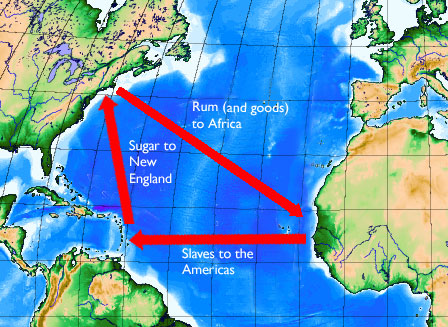What goods were exchanged in the triangular trade system
Black Peoples of America - The Triangular Trade - History on the Net
Home Slavery Resistance Campaign Abolitionists Thomas Clarkson Sources Teaching google. Slavery Home What is Slavery? Africa Before Transatlantic Slavery The Arrival of European Traders The Triangular Trade The Middle Passage On the Plantations British Involvement in the Transatlantic Slave Trade The development of an Abolition Movement The Pro-Slavery Lobby Arguments and Justifications The Act and its effects Why was Slavery finally abolished in the British Empire?
Suppressing the trade Slavery Timeline. The Triangular Trade The Transatlantic Slave Trade had three stages: STAGE 1 Slave ships from Britain left ports like London, Liverpool and Bristol for West Africa carrying goods such as cloth, guns, ironware and drink that had been made in Britain.
Later, on the West African coast, these goods would be traded for men, women and children who had been captured by slave traders or bought from African chiefs.

STAGE 2 African dealers kidnapped people from villages up to hundreds of miles inland. On the African coast, European traders bought enslaved peoples from travelling African dealers or nearby African chiefs.

The traders held the enslaved Africans until a ship appeared, and then sold them to a European or African captain. It often took a long time for a captain to fill his ship. He rarely filled his ship in one spot.
Instead he would spend three to four months sailing along the coast, looking for the fittest and cheapest slaves. Ships would sail up and down the coast filling their holds with enslaved Africans. There were many cases of violent resistance by Africans against slave ships and their crews. STAGE 3 In the West Indies enslaved Africans would be sold to the highest bidder at slave auctions. Once they had been bought, enslaved Africans worked for nothing on plantations.
They belonged to the plantation owner , like any other possession, and had no rights at all.
BLARE
The enslaved Africans were often punished very harshly. Enslaved Africans resisted against their enslavement in many ways, from revolution to silent, personal resistance. Some refused to be enslaved and took their own lives.
Sometimes pregnant women preferred abortion to bringing a child into slavery. Whenever possible, enslaved Africans ran away.
Some escaped to South America, England or North America. Also there were hundreds of slave revolts.

Two thirds of the enslaved Africans, taken to the Americas, ended up on sugar plantations. Sugar was used to sweeten another crop harvested by enslaved Africans in the West Indies - coffee.
With the money made from the sale of enslaved Africans, goods such as sugar, coffee and tobacco were bought and carried back to Britain for sale. The ships were loaded with produce from the plantations for the voyage home.